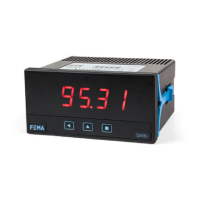FEMA ELECTRÓNICA . Series C . C40-D
11
• Measuring process signals
The instrument accepts the measure of process signals in
4/20 mA and 0/10 Vdc. The instrument provides excita-
on voltage to power up transducers.
• Scaling
The instrument allows to scale the reading to 4 digits (9999 / -1999)
with congurable decimal point to any posion. The ‘second scaling’
funcon can also be used (see secon 1.25).
• Maximum oversignal
‘Maximum oversignal’ is the maximum signal accepted by the instru-
ment. Higher signal values may cause instrument damage. Lower val-
ues are non destrucve but may be out of accuracy specicaons.
• Response mes
The response me to a signal step is 300 mSeconds, independent of
the signal range selected.
• Terminal 5 ‘mulfuncon’ - ‘Vexc’ or ‘External control’
To congure the +15 Vdc excitaon voltage at terminal 5, set internal
jumper ‘T’ at posion 1-2 (see secon 1.9). Transducers with a con-
sumpon of up to 30 mA can be powered from this terminal.
To congure the ‘EK’ external contact funcon at terminal 5, set inter-
nal jumper ‘T’ at posion 4-5 (see secon 1.9). See secon 1.9 for a list
of available funcons.
1.16 Process measures
• Start-up, connecons and jumpers
For instrument start-up follow the steps listed at secon 1.7. Signal
connecons are indicated at secon 1.5. Locaon for internal jumpers
is indicated at secon 1.9.
See below a list of typical connecons :
• signal 4/20 mA acve
• signal 4/20 mA passive • signal 0/10 Vdc passive
signal (
mA-)
+15 Vdc (mA+)
12345
+Vdc
common
+15 Vdc
12345
• signal 0/10 Vdc acve
mA +
mA -
12345
+Vdc
common
12345
Ranges
of measure
Scale
by default
Scalable
Jumper ‘S’
(see secon 1.9)
Jumper ‘T’
(see secon 1.9)
Accuracy
(% FS)
Max.
oversignal
Connecon
(
terminals)
Z
in
4/20 mA
passive
(needs Vexc.)
0/100.0
de 9999
a -1999
D
1-2
<0.15 % 25 mA
2 (signal)
5 (Vexc)
4.7 Ohm
acve
4-5
2 (mA+)
4 (mA-)
0/10 Vdc
passive
(needs Vexc.)
A
1-2
<0.20 % 25 Vdc
2 (+Vdc)
4 (comm.)
5 (Vexc)
1 M
acve 4-5
2 (+Vdc)
4 (comm.)
Table 15 - Ranges of measure for process signals
1.17 Measuring frequency
• How the instrument measures frequency
The instrument measures frequency from an AC voltage
(Vac) or AC current (Aac) signal. The instrument detects
each ‘0’ crossing of the signal, either ‘0 Vac’ or ‘0 Aac’. All
available Vac and Aac signal ranges are accepted as frequency input
signal.
• How to congure the instrument to measure frequency
To measure frequency from a Vac signal, select the internal jumpers for
the desired AC voltage range (see secon 1.9), connect the signal for
the selected voltage range (see secon 1.10), and congure the instru-
ment to measure frequency (see secon 1.29.1). The same applies to
measure frequency from Aac signals. See example at secon below.
• Scaling
The default resoluon is 0.1 Hz. The instrument allows to scale the
reading to 4 digits (9999 / -1999) with congurable decimal point
to any posion. The ‘second scaling’ funcon can also be used (see
secon 1.25).
• Maximum and minimum signal
Frequency signals below 15 Hz are measured as ‘0’. Frequency sig-
nals higher than 100 Hz are out of accuracy. Signals higher than
1000 Hz will read ‘display overow’ ‘d.oVr’ error.
Ranges
of measure
Scale
by default
Scalable AC signal
(see secon 1.9)
Jumper ‘T’
(see secon 1.9)
Response
me
Accuracy
(% reading)
15 Hz to
100 Hz
0/100.0
from 9999
to -1999
select Vac or
Aac range
4-5 70 mSec.
<0.15%
of
reading
Table 16 - Ranges of measure for frequency
• Example
To measure the 50 Hz frequency from a 230 Vac
power line, select jumpers ‘GI’ for 600 Vac signal
range (see secon 1.9), connect signal to termi-
nals ‘1’ and ‘4’ (see secon 1.10), and congure
‘frequency’ at the input signal conguraon
menu (see secon 1.29.1).

